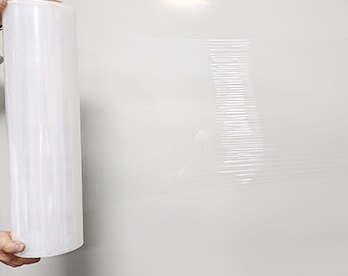

Stretch film is a domestically produced PVC-based film with DOA as a plasticizer, which also provides self-adhesive properties. However, it has drawbacks such as environmental issues, high cost (higher specific weight compared to PE, resulting in a smaller unit packaging area), and poor stretchability. Currently, LLDPE is the primary material, including C4, C6, C8, and metallized PE (MPE). Let's take a look at the characteristics and applications of stretch film!
PE stretch film is primarily blown film, evolving from single-layer to two- and three-layer. Currently, LLDPE stretch film is primarily produced using the cast film method, as cast film production lines offer uniform thickness and high transparency, making them suitable for high-ratio pre-stretching requirements. High-quality stretch film exhibits high transparency, high longitudinal elongation, high yield point, high transverse tear strength, and excellent puncture resistance. The density of the stretch film material also affects its performance. Increasing density results in higher orientation, better flatness, higher longitudinal elongation, and higher yield strength, but lower transverse tear strength, puncture strength, and light transmittance. Therefore, considering these various properties, a medium-density linear polyethylene (LMMS) is formed in the non-adhesive layer.
PE stretch film (also known as roll film) offers high tensile and tear strength, along with excellent self-adhesion, allowing it to wrap objects together and prevent them from loosening during transport. This film offers excellent transparency, creating an aesthetically pleasing wrapping effect, while also providing waterproof, dustproof, and damage-resistant properties.

Specific Features of Stretch Film (Wrap Film):
1. Unitization: This is a key characteristic of wrap film packaging. The film's strong winding and shrinkage properties allow products to be tightly and securely bundled into a single unit, consolidating small components. Even in adverse environments, the product will not loosen or separate. The lack of sharp edges and adhesive properties prevents damage.
2. Primary Protection: Primary protection provides surface protection for the product, creating a lightly protective coating around the product to protect against dust, oil, moisture, water, and theft. Crucially, wrapping film ensures uniform force on the packaged item, preventing damage caused by uneven force. This is something traditional packaging methods (such as strapping, wrapping, and tape) cannot achieve.
3. Compression and Securement: The shrinkage force of the wrapping film is used to wrap the product, creating a compact, space-saving unit. This secures each pallet securely, effectively preventing product displacement and movement during transport. Adjustable tension also ensures close contact between rigid products.
4. Cost Savings: Using wrapping film for product packaging can significantly reduce operating costs. Only about 15% of original box packaging, about 35% of heat shrink film, and about 50% of cardboard packaging use stretch film. This reduces worker labor intensity, improves packaging efficiency, and improves packaging quality. Applications of Stretch Film (Roll Film):
Stretch film (also known as roll film) is primarily used in conjunction with pallets, replacing small containers for packaging individual goods. Because it can reduce packaging costs for bulk cargo transportation by over 30%, it is widely used for bulk packaging of numerous products in industries such as electronics, building materials, chemicals, metal products, automotive parts, wire and cable, daily necessities, food, and papermaking. In warehouse storage, to save space and floor space even abroad, stretch film pallets are often used for three-dimensional storage and transportation.
| Efficiency Factor | Traditional CNC/Line Production | Screw Machine Advantage |
|---|---|---|
| Changeover Time | Hours long setup adjustments | 1530 minute material program tool swaps |
| Precision Stability | Vibration issues with slender parts | Rigid guide bushing prevents deflection |
| Material Adaptability | Manual parameter trials per material | Instant program adjustments cut waste |
| Complex Micro-Parts | Multiple machine handoffs required | Single setup multiaxis complete machining |
| Energy Consumption | Constant high power draw | Servo motors cut idle power by 2540% |
| Floor Space | Large machine footprints | Compact 35 sqm per unit layout |
| Labor Efficiency | Multiple operators per line | One skilled worker runs 35 machines |
| Unit Cost Control | High depreciation energy labor overhead | 35% lower total cost per 100 titanium parts |